Nuevo Oráculo. Divertimento animado para impresora sampleada e intrumentos de percusión. Modulo de Led de 50 x 50 cm. 15′ 53». 2023.
Las ideas, al igual que las imágenes, mutan, incluso con el simple hecho de verbalizarlas, mirarlas, volver a pensar en ellas o dibujarlas en un papel. Pero, es al materializarlas, al llevarlas a la práctica, cuando Juan Carlos Bracho está especialmente atento a qué acontece. Observa y reflexiona sobre cómo se transforman esas ideas, cómo esas imágenes cobran forma y surgen nuevas narraciones paralelas o divergentes por el camino; semillas que del recolecto y hace brotar con tanta paciencia como determinación, por muy dilatado que sea su tiempo de germinación.
Durante más de una década Bracho ha ido encadenando diferentes lecturas estéticas y conceptuales a partir de observar atentamente su propio proceso de trabajo, y los errores de su impresora casera. Nuevo Oráculo es el último capítulo hasta la fecha de este viaje por el color y el paisaje, desde la abstracción más radical; una materia y un tema que han recorrido intermitentemente la historia de la pintura y el pensamiento.
Lo Quiero Todo (+info), Pedro, Otra Vida Futura I/II (+info), Oráculo (+info) y La Mano Amiga (+info) -proyectos todos ellos surgidos del error- se vuelven a fusionar en Nuevo Oráculo; una pieza musical compuesta en colaboración con María de Grandy, LUX (Jaime Martín) y Sofía Martínez
Nuevo Oráculo es un Divertimento animado para impresora sampleada e instrumentos de percusión dividido en cinco movimientos y una coda.
Los cuatro primeros están dedicados a un color (negro, amarillo, magenta y cian) y a un instrumento (impresora, glokenspiel, marimba y campana tubulares), el quinto al círculo cromatico junto a un esemble de percusión, más una coda que cierra el Divertimento fusionando todos los colores de una forma aleatoria.
Así el negro/impresora, el amarillo/gloklenspiel, el magenta/marimba, el cyan/campanas tubulares y el círculo cromático/esemble de percusión se acompañan de una videoanimación donde los miles de errores de los cien monocromos multipáginas recogidos en el libro Oráculo, y que han servido como partitura visual para Nuevo Oráculo, se transforman en impulsos lumínicos recorriendo todo el espectro del color pigmento.
En cada uno de los movimientos, esos errores se mueven, entran y salen, se suman o se restan con un montaje diferente y relacionado con la composición musical y la sonoridad del instrumento
Todas las obras que condensa Nuevo Oráculo son, en definitiva, una intensa oda al azar y al error en clave sintética y codificada, a la vez que una apuesta desinhibida por la belleza, intensamente emocional, sensual y evocadora. En su conjunto, suponen un viaje de ida y vuelta -con toda la pérdida y la ganancia que ello conlleva- de lo manual a lo mecánico, de lo analógico a lo digital, del pigmento a la luz, y de lo abstracto a lo concreto. Una profunda reflexión sobre el color -y el no color- a través de la construcción de paisajes mentales, visuales, sonoros y literarios.
Nuevo Oráculo. Animated divertimento for sampled printer and percussion instruments. Led module of 50 x 50 cm. 15′ 53». 2023
Ideas, like images, mutate, even with the simple act of verbalizing them, looking at them, rethinking them, or drawing them on paper. But it is when materializing them, when putting them into practice, that Juan Carlos Bracho is especially attentive to what happens. He observes and reflects on how those ideas transform, how those images take shape, and new parallel or divergent narratives emerge along the way; seeds that he gathers and makes sprout with as much patience as determination, no matter how long their germination time may be.
For more than a decade, Bracho has been chaining different aesthetic and conceptual readings from carefully observing his own work process and the errors of his home printer. Nuevo Oráculo is the latest chapter to date in this journey through color and landscape, from the most radical abstraction; a material and a theme that have intermittently traveled through the history of painting and thought.
Lo Quiero Todo, Pedro, Otra Vida Futura I/II, Oráculo, and La Mano Amiga—all projects born from error—merge again in Nuevo Oráculo; a musical piece composed in collaboration with María de Grandy, LUX (Jaime Martín), and Sofía Martínez. Nuevo Oráculo is an animated Divertimento for sampled printer and percussion instruments, divided into five movements and a coda.
The first four movements are dedicated to a color (black, yellow, magenta, and cyan) and an instrument (printer, glockenspiel, marimba, and tubular bells), with the fifth dedicated to the color wheel along with a percussion ensemble, plus a coda that closes the Divertimento by randomly merging all the colors.
Thus, the black/printer, yellow/glockenspiel, magenta/marimba, cyan/tubular bells, and color wheel/percussion ensemble are accompanied by a video animation where the thousands of errors from the hundred monochrome multi-page prints collected in the Oráculo book, which have served as a visual score for Nuevo Oráculo, are transformed into light impulses traversing the entire pigment color spectrum.
In each of the movements, these errors move, enter and exit, add or subtract with a different editing style, linked to the musical composition and the sound of the instrument.
All the works condensed in Nuevo Oráculo are, ultimately, an intense ode to chance and error in a synthetic and coded key, as well as an uninhibited bet on beauty—intensely emotional, sensual, and evocative. As a whole, they represent a round trip—with all the loss and gain it entails—from the manual to the mechanical, from the analog to the digital, from pigment to light, and from the abstract to the concrete. A profound reflection on color—and no color—through the construction of mental, visual, sonic, and literary landscapes
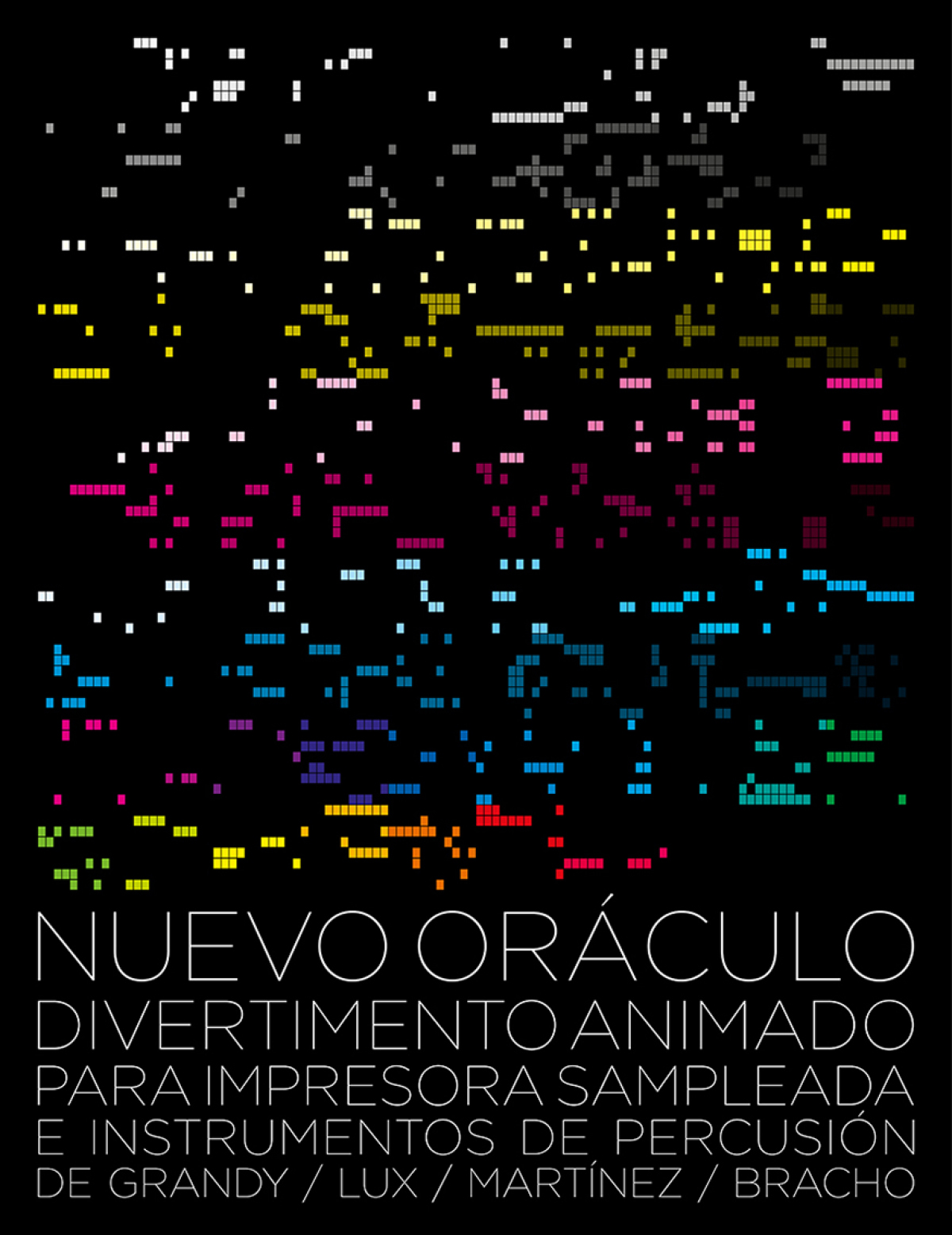

Ier Movimiento. Negro / Impesora
Para la composición del primer movimiento, donde la absoluta protagonista en la impresora, se registraron todos sus sonidos: encendido, modos de impresión, reseteo, limpieza y apagado.
Estas grabaciones son las que LUX ha manipulado, sampleado y distorsionado para crear un diálogo entre un corazón y una máquina.
A ese latido cadencioso, que nos presenta en los primeros once compases la cuadrícula blanca y vacía del multipágina, se van sumando sonidos y colores -del gris más claro hasta llegar al negro absoluto- en un movimiento circular que recorre veinte veces la pantalla salpicándola con cientos de errores y veinte matices de negro.
El resultado es una suerte de «overtura» industrial, ruidista y repetitiva, pero llena de matices y sutilezas, que en su clímax sonoro y visual nos anima a bailar.
Ist Movement. Black / Printer
For the composition of the first movement, where the printer is the absolute protagonist, all its sounds were recorded: powering on, printing modes, resetting, cleaning, and powering off.
These recordings are the ones LUX has manipulated, sampled, and distorted to create a dialogue between a heart and a machine.
To that rhythmic heartbeat, which is presented in the first eleven measures as the white and empty grid of the multipage, sounds and colors are gradually added—from the lightest gray to absolute black—in a circular movement that traverses the screen twenty times, splattering it with hundreds of errors and twenty shades of black.
The result is a sort of industrial overture, noisy and repetitive, yet full of nuances and subtleties, which, in its sonic and visual climax, encourages us to dance

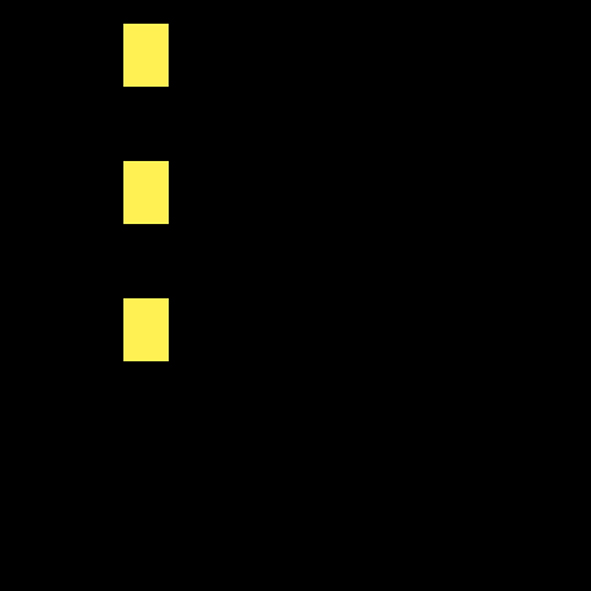
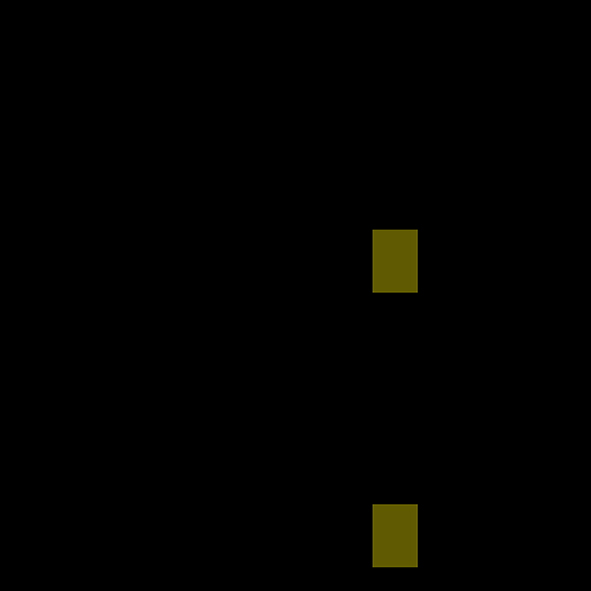
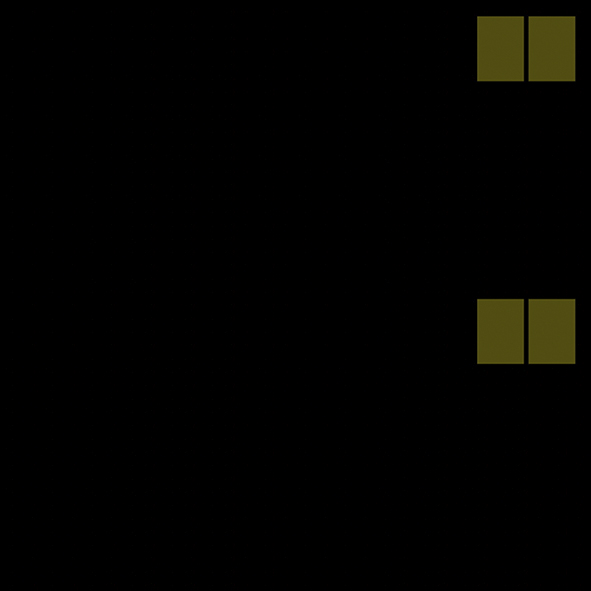
2º Movimiento. Amarillo / Glokenspiel
En el segundo movimiento dedicado al Glokenspiel, chispeante, punzante y agudo como el amarillo, los colores saltan y avanzan en un movimiento circular por la cuadrícula; una sucesión de repeticiones y cadencias que, como en todos las demás gradaciones, van del amarillo más claro, casi blanco, al más oscuro casi negro.
A la mitad de la escritura, cuando aparece el negro en la suma del color, la sonoridad se vuelve cada vez más metálica y estridente. Se trata de una segunda voz electrónica conseguida aplicando síntesis granular a la partitura de María de Grandy,
Esta duplicación de las notas tratadas sintéticamente dialoga con el metal del instrumento hasta casi anularlo por completo, volviendo la escucha un tanto irritante, pues su volumen va aumentando en la misma proporción que lo hace la mezcla de amarillo y negro.
2nd Movement. Yellow / Glockenspiel
In the second movement dedicated to the glockenspiel, sparkling, piercing, and sharp like yellow, the colors leap and move in a circular motion across the grid; a succession of repetitions and cadences that, like in all the other gradations, go from the lightest yellow, almost white, to the darkest, almost black.
Halfway through the piece, when black appears in the sum of the color, the sound becomes increasingly metallic and strident. It is a second electronic voice achieved by applying granular synthesis to María de Grandy’s score.
This duplication of the synthetically processed notes interacts with the metal of the instrument until it almost completely nullifies it, making the listening experience somewhat irritating, as its volume increases in the same proportion as the blend of yellow and black

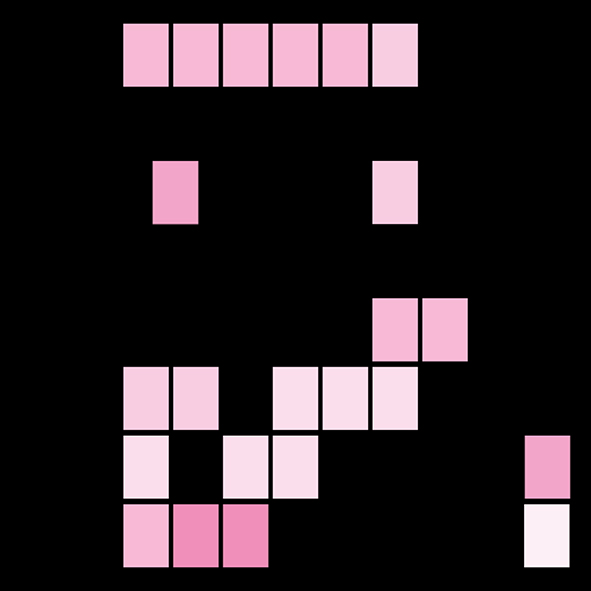
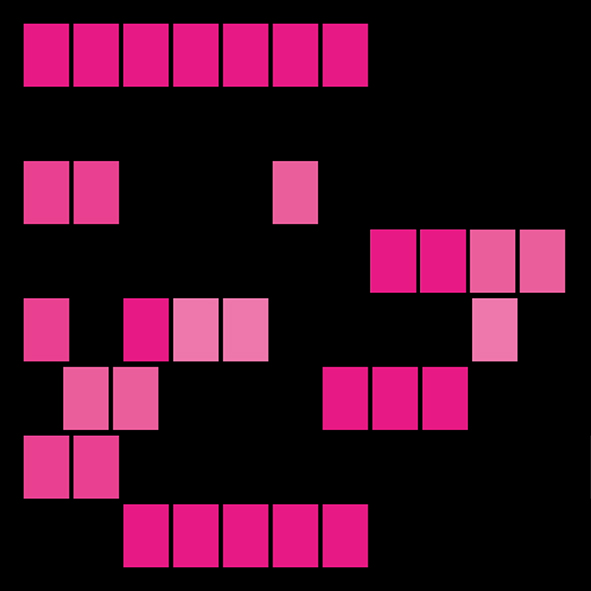
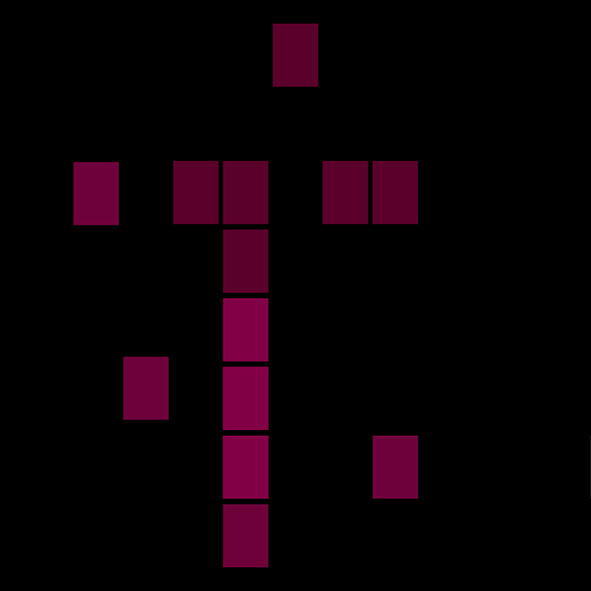
3rd Movimiento. Magenta / Marimba
Para animar a la marimba en el tercer movimiento, los errores distribuidos por las diferentes cuadrículas -agrupados o individualmente- se deslizan por la pantalla, al igual que las baquetas recorren y hacen sonar las láminas del instrumento. Entran y salen al compás de la música recorriendo todos los matices del magenta.
El magenta, cálido por excelencia, sus rosados y sus profundos granates dibujan y redibujan composiciones abstractas -aunque una cara sonriente parezca guiñarnos un ojo-, acompañando o acompañadas por el sonido dulce, profundo y amaderado de la marimba.
La impresora, literalmente, aparece tan solo en dos ocasiones puntuales de la escucha, justo con la entrada del negro en la ecuación de color, y al final, acompasándose y duplicando por momentos las notas de la marimba para cerrar el movimiento.
3rd Movement / Magenta / Marimba
To animate the marimba in the third movement, the errors distributed across the different grids—grouped or individually—slide across the screen, just as the mallets move over and make the instrument’s bars sound. They enter and exit in time with the music, covering all the nuances of magenta.
Magenta, the quintessential warm color, with its pinks and deep burgundies, draws and redraws abstract compositions—though a smiling face may seem to wink at us—accompanying or being accompanied by the sweet, deep, and woody sound of the marimba.
The printer literally appears only on two specific occasions during the listening: just with the entry of black in the color equation, and at the end, synchronizing and occasionally duplicating the marimba’s notes to close the movement.

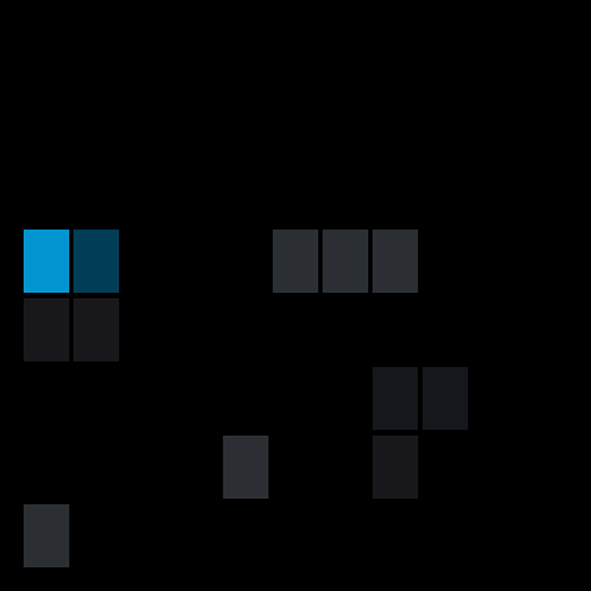
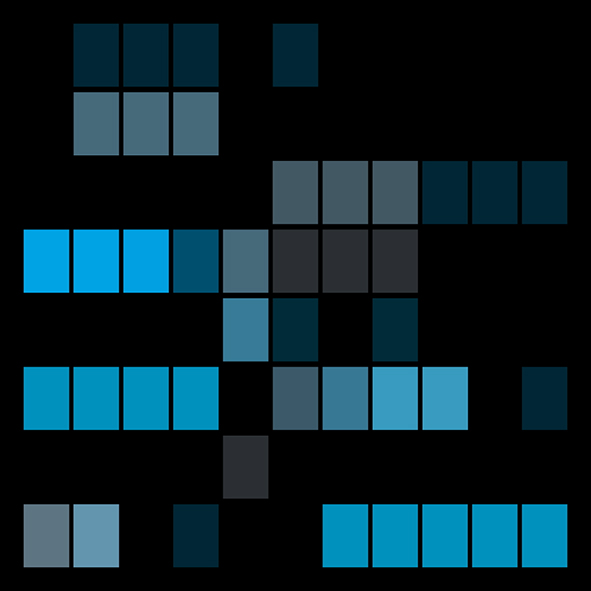
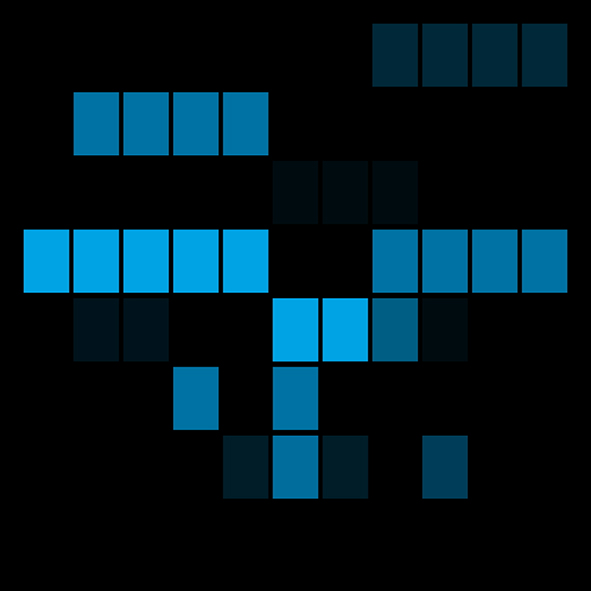
4º Movimiento. Cian / Campanas tubulares
En el cuarto movimiento, el más solemne e introspectivo de todos, las campanas tubulares despiertan al cIan desde la oscuridad total, pues con cada tañido surgen lentamente y emergen todos sus matices.
En una reverberación sin fin, la música y el color, su espectro e intensidades, fusionan y dilatan sus notas y su corporeidad en un juego de apariciones, ecos y llamadas.
Cada golpe al metal, ya de por sí dilatado en su tiempo de escucha, se transforma,se expande y se solapa sutilmente con la siguiente nota, a veces casi de manera imperceptible, gracias a los efectos atmosféricos que LUX consigue troceando y distorsionando el sonido de la impresora.
Aqui la impresora, presente desde la primera nota, está justificada por el uso de la opacidad que levanta al color desde el negro hasta su matiz en el espectro cromático, dotando al sonido y a la imagen de una profundidad siniestra y espectral.
4th Movement. Cyan / Tubular Bells
In the fourth movement, the most solemn and introspective of all, the tubular bells awaken the cyan from total darkness, as with each chime, all their nuances slowly emerge.
In an endless reverberation, music and color, their spectrum and intensities, merge and expand their notes and corporeality in a game of appearances, echoes, and calls.
Each strike to the metal, already stretched out in its listening time, transforms, expands, and subtly overlaps with the next note, sometimes almost imperceptibly, thanks to the atmospheric effects LUX achieves by chopping and distorting the sound of the printer.
Here, the printer, present since the first note, is justified by the use of opacity that lifts the color from black to its shade in the color spectrum, endowing the sound and the image with a sinister and spectral dept.

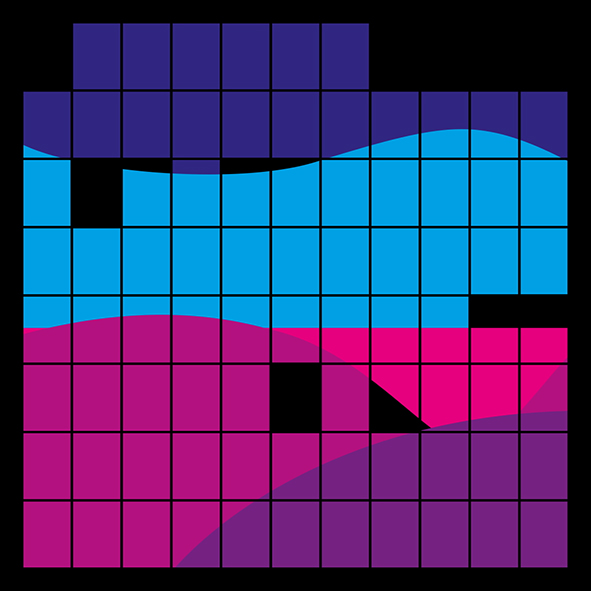

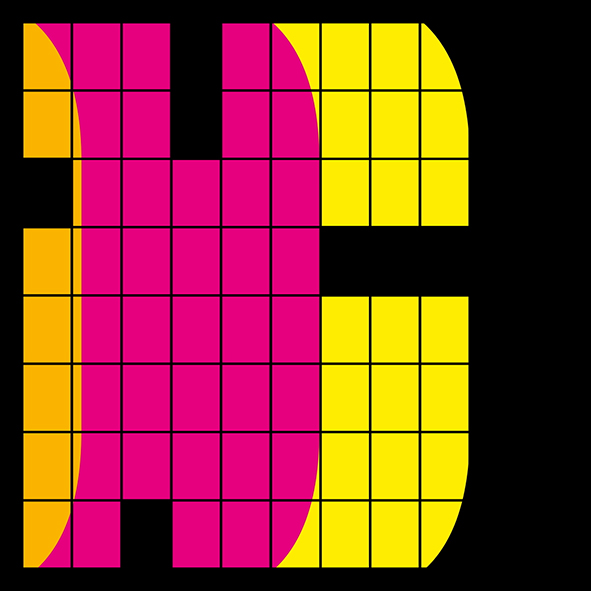
5º Movimiento. Círculo cromatico / Ensemble de percusión
El quinto movimiento es un recorrido por el círculo cromático en una secuencia de dieciocho colores; los tres primarios más seis gradaciones entre cada uno de ellos.
Si en el resto de movimientos se han animado los errores/colores dentro de la cuadrícula, en este último las cuadrículas aparecen casi completamente coloreadas, pues tan solo se han vaciado los errores, dando como resultado grandes manchas de color salpicadas por geometrías en negro.
A los tres instrumentos solistas -marimba, glokenspiel y campanas tubuares- y los colores primarios -magenta, cian y amarillo- se suman naranjas, verdes, morados, rojos, azules y violetas, y los nuevos sonidos de un güiro, un vibraslap, una caja, platillos, cortinillas, semillas, un shaker, un gong o un pandero.
El movimiento evoluciona en tres secciones, con un interludio solista entre ellas, y una coda hasta completar el círculo cromático.
5th Movement. Color Wheel / Percussion Ensemble
The fifth movement is a journey through the color wheel in a sequence of eighteen colors: the three primary colors plus six gradations between each of them.
While in the other movements, the errors/colors have been animated within the grid, in this last one, the grids appear almost completely filled with color, as only the errors have been emptied, resulting in large color patches splattered with black geometries.
The three solo instruments—marimba, glockenspiel, and tubular bells—and the primary colors—magenta, cyan, and yellow—are joined by oranges, greens, purples, reds, blues, and violets, as well as new sounds from a güiro, vibraslap, snare, cymbals, curtains, seeds, a shaker, a gong, and a tambourine.
The movement evolves in three sections, with a solo interlude between them, and a coda to complete the color wheel.
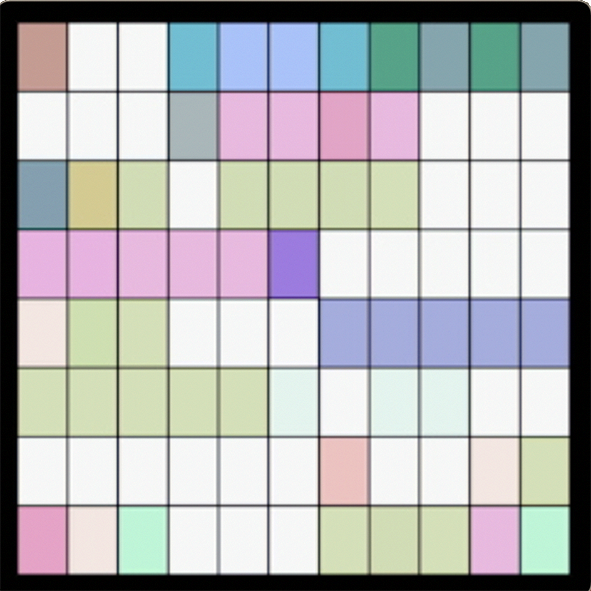
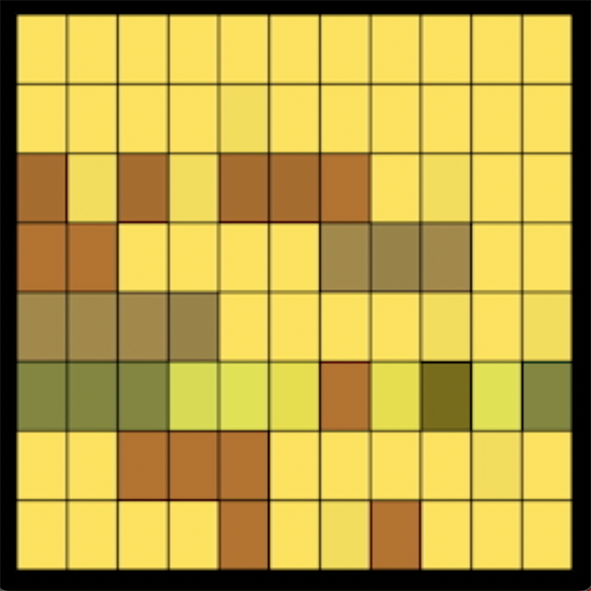
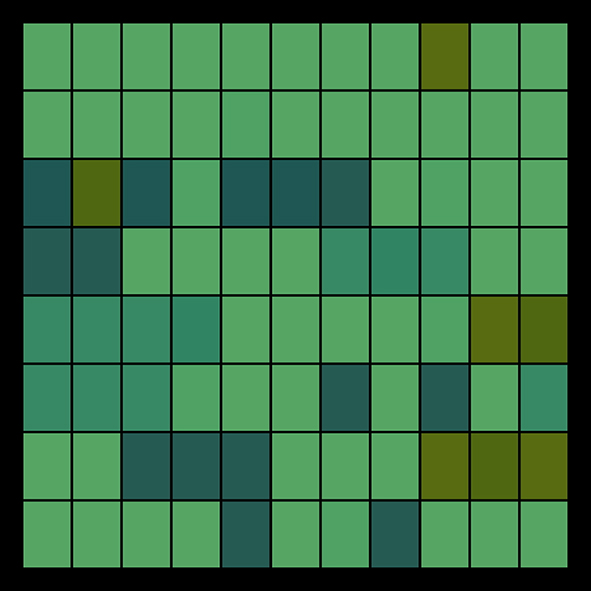
Coda
El final, o modo de coda, es un diálogo enloquecido entre los instrumentos solistas y una sucesión animada de las cuadrículas sin orden ni sentido, en una secuencia de opacidades que dan como resultado la aparición de cientos de nuevos colores y matices; metáfora visual y sonora de las infinitas combinaciones posibles en la creación musical y plástica.
Coda
The ending, or coda, is a frenzied dialogue between the solo instruments and an animated succession of grids with no order or sense, in a sequence of opacities that results in the appearance of hundreds of new colors and shades; a visual and sonic metaphor for the infinite possible combinations in musical and artistic creation.


